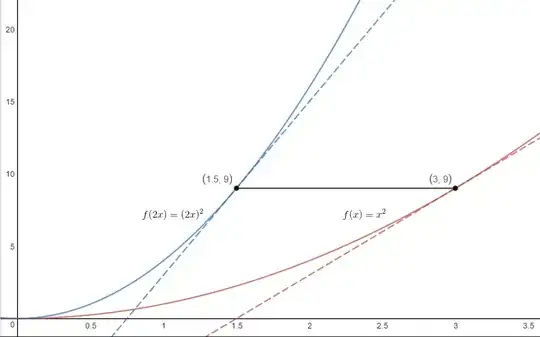Others have already answered the question directly and provided good intuition for why the chain rule works, so I will just add a graphical interpretation of the chain rule in the form $[f(g(x))]'=f'(g(x))g'(x)$.
By far the best explanation of this form I've seen is found here, but I will summarize the answer in case the link ever becomes broken.
Consider two functions, $f(x)=x^2$ and $f(2x)=(2x)^2$:

Notice that the range of both functions stays the same, since only the rate of input is being modified. Also notice that $f(2x)$ is "scrunched", since it is cycling through its input twice as fast.
Now, consider the tangent lines to the graph at the two points marked in the picture. Although the outputs of the function are the same ($f(2*1.5) = f(3)$), the slope of $f(2x)$ at $(1.5,9)$ is steeper than the corresponding slope at $(3,9)$ (in fact, twice as steep). The reason for this, in the words of the aforementioned article, is that slope is "rise over run", and you have half as much "run" on $f(2x)$ than you do for the equivalent point on $f(x)$. (By "equivalent", I mean points such as $(1.5, 9)$ and $(3,9)$ for two functions $f(g(x))$ and $f(x)$, respectively.)
Relating this back to the formula $[f(g(x))]'=f'(g(x))g'(x)$, we have $f(x)=x^2$ and $g(x)=2x$. If we want to calculate the slope at $x=1.5$ for $f(2x)$, what this formula is saying is "take the ORIGINAL slope at $(3,9)=(1.5, f(2*1.5))$, and scale it by how fast $g(x)$ is changing." Since $g(x)$ is changing twice as fast as the input to $f$ normally changes without composition, you will have exactly $\frac{1}{g'(x)}=\frac{1}{2}$ as much "run" in your slope at $(1.5,9)$ compared to $(3,9)$, and thus you need to scale the original slope at $(3,9)$ by $g'(x)=2$ in this example.
In general, if you have a composite function in the form of $f(g(x))$, the input to $f$ is changing $g'(x)$ as fast the input normally changes without composition, and thus you need to scale the slope at $f(g(x))$ by exactly $g'(x)$.

